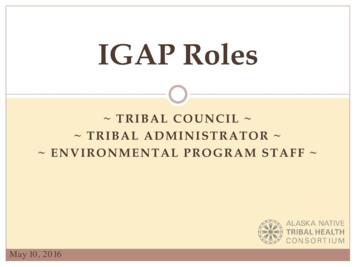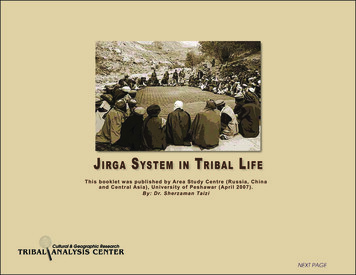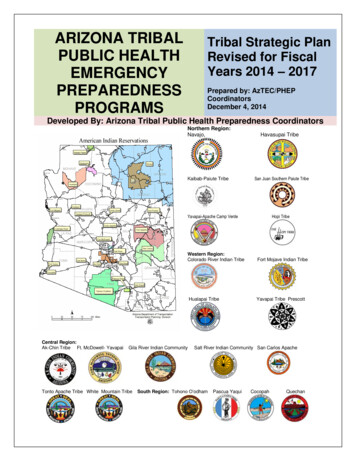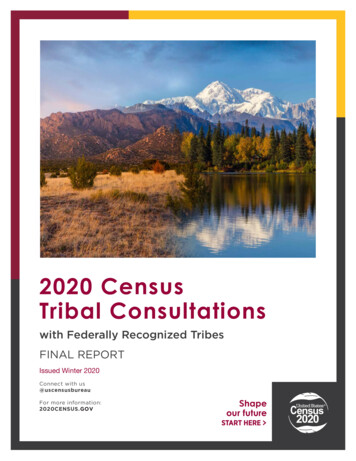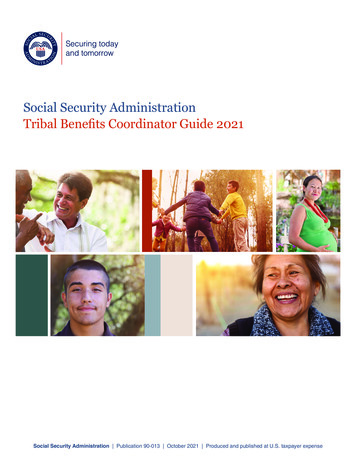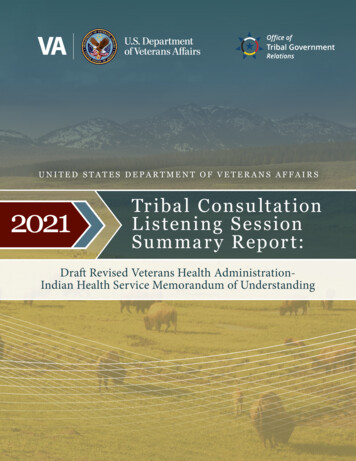
Transcription
1TRIBAL HEALTH DEPARTMENTGUIDE TOSELF-STUDYAn In-Depth Approach To Tribal Health DepartmentCapacity Assessment For Accreditation PreparationBased on the Public Health Accreditation Board’sTribal Standards and Measures, Version 1.0Adapted from the Guide to Organizational Self-Study Process,National Association of County and City Health Officials.This guide was supported by funds made available from the Centers for Disease Control and Prevention, Office for State, Tribal, Local and TerritorialSupport, under Grant #3U38HM000449-05S1, CFDA #93.524 and Grant # 5U38HM000449-05, CFDA 93.283. The content of this guide are those of theauthors and do not necessarily represent the official position of or endorsement by the Centers for Disease Control and Prevention.
2INTRODUCTIONTribal Health Departments (THDs) are increasingly involved in public health activities in rapid response to the changinghealth needs of American Indian and Alaska Native communities. Tribes recognize the importance of strengthening publichealth infrastructure as a means for generating resources and increasing efficiency and effectiveness of programs and services. A stronger Tribal public health infrastructure may lead to improvements in health outcomes and greater capacity torespond to the important public health needs of the community.Public health accreditation is a process by which a THD can measure its performance against a set of national standardsand measures (Stds/Ms) as established by the Public Health Accreditation Board (PHAB), a non-profit organization servingas the accrediting body for Tribal, state, local and territorial public health departments. As a part of the accreditation process, aspiring THDs will undergo a self-study to identify strengths and discover gaps in THD performance based on the Stds/Ms. THDs may have conducted similar self-studies when pursuing accreditation of Tribal clinics, hospitals, or ambulatorycare facilities through other accrediting bodies, such as the Accreditation Association for Ambulatory Health Care or theJoint Commission on Accreditation of Healthcare.Tribal public health systems are complex and include a variety of partners and stakeholders that work together to protect and promote community health. Diagram 1. illustrates some of the partners with which aTHD might coordinate services. Given that each Tribal system is unique,the scope and level of coordination between a THD and its partners willvary. Engaging partners in the accreditation process is critical, becausethe standards address the THD’s capacity to work with its partners to fulfilla range of core public health functions and services that are fulfilled byvarious entities, divisions, and programs. These programs include, butare not limited to, environmental public health, health education and promotion, chronic and communicable disease prevention and control, injuryprevention, and access to care. The Stds/Ms also address areas of publichealth law, governance, finance, human resources, and administration.Since many programs and services are delivered in partnership or in coordination with others, it is important to identify ways to include the mostappropriate Tribal public health system partners in the self-study process.DIAGRAM 1.TRIBAL sACCREDITATION READINESSPlanning and preparing for public health accreditation is a complex process that includes many steps. The complexities aredue, in large part, to the fact that accreditation readiness is not a linear process where one step follows another. On thecontrary, many tasks are undertaken concurrently, and in some cases, synergistically. By synergistically, we mean tasks andactivities are completed at the same time, and in coordination, in order to achieve a better result than if they were completed independently of one another. For purposes of this guide, we have divided public health accreditation preparationactivities into three primary Readiness Areas:Organizational Readiness, Public Health Performance, and Community Health Improvement Planning Organizational Readiness is the cornerstone to readiness efforts. It focuses on Tribal Leadership and resources neededto plan and prepare for accreditation. Leadership support from the Tribal Health Department director, Tribal Council,and health committees, among others, is critical to facilitating system-wide engagement in the process. Public Health Performance focuses on the THD infrastructure (including processes, competencies, relationships, andresources) required to perform public health’s core functions and essential services in the community. Community Health Improvement Planning focuses on accreditation prerequisites: the community health assessment(CHA), a community health improvement plan (CHIP), and an organizational strategic plan. Combined, these threeprerequisites work together to improve health outcomes. The CHA provides information about the community’shealth status to inform the CHIP, and the strategic plan addresses the THD’s internal operational capacity to supporthealth improvement planning.
3Accreditation readiness activities are often interdependent and connected across readiness areas. When connectionsbetween and among activities are identified, and those activities are conducted in coordination with one another, the outcomecan lead to Tribal public health functions and services that are more meaningful, strategic, and impactful.Accreditation and the Three SistersThe analogy of the three sisters – corn, beans and squash – might be helpful in understanding what is meant byinterdependent and connected. Many Tribes have a long tradition of planting and harvesting the three sisters togetherbecause of the synergistic relationship between the three. When planted and nurtured together, the three form aninterdependent relationship that allows them to thrive together and provide high yields that benefit community health. Thisis commonly referred to as companion planting. In the same way companion planting produces a more abundant harvest,coordinated public health activities achieve better results than those that are completed in isolation of each other.Like corn, Organizational Readiness can serve as a pillar for public health performance. Tribal Leadership engagement willhelp ensure a THD has the support and resources it needs to formalize internal and external partnerships, develop policiesand plans, and build an infrastructure to support quality services that address the most pressing needs of the community.Public Health Performance can be likened to beans, which grow up the corn stalk, stabilizing the corn and making it lessvulnerable to weather and other elements. Likewise, quality public health performance can stabilize Tribal public healthinfrastructure, bolster management practices, and develop leadership. Bean plants also provide nutrient-rich nitrogen tothe soil to strengthen the other plants in the same way the public health performance can strengthen the organization andcommunity health improvement planning process.Much like squash provides the ground cover to ensure the corn and beans have the nutrients and moisture required tothrive and bear the most fruit, the Community Health Improvement Planning process strives to make decisions based onaccurate and recent data in order to ensure that programs and services are meaningful, purposeful and strategic, thusproviding the ground cover for planned health improvements to transpire.Importance of Tribal Leadership SupportTribal Leadership should be engaged in accreditation efforts from the beginning and continually throughout the accreditationprocess. Tribal Leadership may include Tribal Council, the health committee or boards, and the health director. TribalLeadership support is important throughout the accreditation process, but especially during the self-study when the THDreviews the Stds/Ms addressing governance, public health law, and policy. Leadership support will also be important when theTHD asks key staff and other Tribal departments to participate in the self-study.Identify an Accreditation CoordinatorAfter deciding to pursue public health accreditation, the health director should recruit or appoint an Accreditation Coordinator(AC), who will provide leadership throughout the accreditation process. According to PHAB, the health director may not serveas the AC, so it will be important to select an individual with leadership and communication skills. The AC will be the point ofcontact between the THD and PHAB throughout the entire accreditation process. Analytic, organizational and team-buildingskills are also essential. The AC is the ideal person to coordinate the self-study, since he or she will need to identify and recruitparticipants, facilitate meetings, and manage tasks assigned to staff.RESOURCE!Review the following PHAB document for more guidance on selecting an AC. Considerations for Selecting an Accreditation Coordinator, Public Health Accreditation Tip-Sheet-March-2012.pdfFor more information about how the self-study fits in with other accreditation readiness activities, check out theTribal Public Health Accreditation Readiness Guidebook and Roadmap at www.redstar1.org/resources.
4STEPS TO COMPLETE A SELF-STUDYTHD self-study is an important first step in addressing the Public Health Performance Readiness Area because it providesimportant information for performance and quality improvement efforts. The self-study process offers many benefits fora health department. The process itself provides a means for understanding a THD’s systems, operations, processes, andpolicies in order to strengthen services. If a THD is considering accreditation, then the self-study process and results can beused to better understand accreditation readiness and inform decision making about whether to pursue accreditation as ashort- or long-term goal. Assessment results can also be used to identify strengths and opportunities for quality improvement,community health improvement, and strategic planning, all of which are requirements of public health accreditation.The purpose of the THD Guide to Self-Study is to provide a step-by-step approach to conducting in-depth self-study inpreparation for PHAB accreditation. This guide is adapted from a number of tools, including the National Association of Countyand City Health Official’s (NACCHO) Organizational Self-Assessment Guide. This guide provides broad guidance on conductinga self-study that follows five principal steps and two additional steps that describe how to use your self-study results toimplement quality improvement (QI).This guide provides broad guidance on completing the following seven steps in conducting a self-study:Step 1: Initial preparationStep 2: Gather documentation and score measuresStep 3: Identify and analyze strengths and improvement opportunitiesStep 4: Prioritize areas for improvementStep 5: Develop and implement a work plan to address Stds/MsStep 6: Implement QIStep 7: Institutionalize self-study and continuous QI processesAfter completing a self-study (Steps 1-5), the THD will have a list of top priority areas for improvement. Finishing theself-study process is valuable, but acting on the results of the process is where improvements are actually made (Steps 6-7). Theself-study serves as a precursor to QI efforts because the results of the process can be used to address identified gaps throughQI processes. Ideally, the self-study and continuous QI process should be part of the THD’s planning cycle and repeated atregular intervals, with demonstrated improvements along the way. Ongoing performance assessment and improvement mayimprove the THD’s efficiency and effectiveness in addressing the health needs of Tribal communities (Step 7).The approach described in this guide is not intended to prescribe what and how specific activities should be conducted; rather,it offers THDs an approach to preparing and conducting a self-study, and then using the study’s results. THDs are diverse interms of size, structure, governance, population, jurisdiction, and partners, so adapting the recommended approach or usingan alternate approach may be necessary. Whatever the approach, remember that self-study is an iterative process – one thatis repeated in order to achieve the best outcome possible.Tribal Self-Study ToolIt is highly recommended that a THD use the Self-Assessment Workbook for Tribal Public Health Departments or the TribalHealth Department Self-Study Tool: Tribal Health Department Capacity Assessment for Accreditation Preparation. Theself-assessment workbook is a Microsoft Excel based tool developed by the Institute for Wisconsin’s Health, Inc. (IWHI) aspart of Wisconsin’s Public Health Quality Initiative. The self-study tool is the same as the workbook, but comes in a fillableAdobe PDF. Either tool can be used to facilitate a collaborative approach to reviewing the standards and measures andidentifying potential documentation. Used with the PHAB Standards and Measures Version 1.0 and the PHAB Guide toNational Health Department Accreditation, both tools provide a rating system for scoring a THD’s capacity to address eachmeasure. After completing the self-assessment, you can average the scores and produce a radar chart that illustrates theoverarching strengths and areas of improvement identified by domain.RESOURCE! Self-Assessment Workbook for Tribal Public Health Departments, Institute for Wisconsin’s Health.www.instituteforwihealth.org/tribal.html Tribal Health Department Self-Study Tool: Tribal Health Department Capacity Assessment for AccreditationPreparation, Red Star Innovations and NACCHO.www.redstar1.org/resources and ion/teams.cfm
5STEP 1: INITIAL PREPARATIONThis step is primarily the responsibility of the health director, the AC, or both. Initial preparation includes the following threetasks, which will likely overlap: Develop the work plan. Provide accreditation orientation for all THD staff. Train the self-study participants.Develop the Work PlanIt is important to determine the best way to structure the self-study. There are several ways to do it, and each THD shouldaccommodate its own specific needs and organization capabilities. The method used may depend on the size of the healthdepartment. Methods used by other health departments include:Option 1: The self-study participants include the AC, senior management, and program staff. In this model, seniormanagement, including division directors, assign specific domains or Stds/Ms to staff in their respective divisions or programsbased on area of expertise (e.g., the health education program manager may be in charge of Domain 3 – Inform and educateabout public health issues and functions – and may delegate the Stds/Ms under Domain 3 to the THD’s community healtheducator). These staff members gather documentation for their assigned Stds/Ms and score each measure based on theirfindings. Senior management then analyzes these results and makes recommendations. This option is commonly used in largehealth departments.Option 2: The self-study participants include the AC and senior management. Together they divide all the standards andmeasures among themselves and complete the entire process, including gathering documentation, scoring standards,analyzing results, and making recommendations. This option is typical in mid-sized health departments.Option 3: The self-study participants include the AC and the health director, who will complete the entire self-study process.This option works well with small health departments.If the THD uses any of these options, it may want to consider organizing the workload by grouping two or more closely relateddomains, and then assigning a domain grouping to a team of self-study participants. Even if there is not enough staff to divideinto domain teams, the individuals conducting the self-study can still use these domain groupings to focus their approach.Reviewing the related domains in sections promotes efficiency, especially for individuals with expertise in more than onedomain. Suggested groupings are summarized in Table 1.TABLE. 1 - SUGGESTED DOMAIN GROUPINGSDomains 1 and 2: Surveillance, Investigation, andEnvironmental Public Health HazardsDomains 3, 4, 7, 10: Health Education, Promotion,Prevention, and Evidence-Based Practices Domain 1: Conduct and disseminate assessments focused onpopulation health status and public health issues Domain 2: Investigate health problems and environmentalpublic health hazards to protect the community Domain 3: Inform and educate about public health issuesand functions Domain 4: Engage with the community to identify and addresshealth problems Domain 7: Promote strategies to improve access to healthservices Domain 10: Contribute to and apply the evidence base ofpublic healthDomains 5, 6, 12: Policies, Plans, Laws and GovernanceDomains 8, 9 and 11: Workforce, PerformanceManagement & QI, and Administration Domain 5: Develop public health policies and plans Domain 6: Enforce public health laws Domain 12: Maintain capacity to engage the public healthgoverning entity Domain 8: Maintain a competent public health work force Domain 9: Evaluate and continually improve processes,programs and interventions Domain 11: Maintain administrative and management capacity
6Though the suggested group structures have been successful with other health departments, there is no one ‘right’ way toundertake this process. The health director and the AC must put careful consideration into the best method for the THD.Note: The remainder of this document may seem to refer to larger groups that follow Option 1, but this guidance is intended toaccommodate all THDs, regardless of the model that is used. Whether the group consists of multiple members or is comprisedof only one or two individuals, each step in this guide will need to be completed.Once the best approach has been selected, the AC may develop a work plan for the self-study. The work plan should outlinethe steps and activities for completing the self-study, including an orientation for THD staff (described below).While developing the work plan, it may be helpful to identify who will participate in the self-study process. These individuals will ultimately be responsible for completing the self-assessment, analyzing the results, and making recommendationsregarding program improvements based on the results. Recall that the purpose of this process is to conduct a comprehensiveself-study of the THD as a whole, and therefore, it is often valuable for the self-study participants to represent members fromall levels of management and staff, and all program areas. This will ensure that the wide range of skills and expertise requiredto conduct the self-study is available.Ideally, the self-study should have broad representation from staff, including: 1) health director; 2) Accreditation Coordinator;3) senior management; and 4) program staff. The composition and size of the self-study team will vary from one healthdepartment to another, and should align with the self-study approach that was previously identified. The health director andAC should consider the following points when selecting self-study participants: Size of THD.Organizational structure.Manner in which responsibilities are assigned to staff.Workload.Time it will take to collect evidence and adequately complete the self-study.Adequate knowledge of the health department in general, or specific programs.General guidance on selecting staff who will participate in the self-study process, including desired characteristics andresponsibilities, are summarized in Table 2 below.TABLE. 2 - CONSIDERATIONS FOR SELECTING THE SELF-STUDY PARTICIPANTSStaff TypePossible nt THD director Division directors Senior managers ObjectiveEffective delegatorsEffective communicatorsStrong leadership skills Design and lead the process Analyze results Formulate recommendations forcontinuous QI efforts Break tiesObjectiveOrganizedDocumentation skillsSubject matter experts Provide information andexpertise on Stds/Ms Collect and organizedocumentation as evidence formeeting Stds/Ms Serve as ambassadors to generalstaff about the processProject /Program Staff Program managers Program staff
7Participation of Tribal administration, departments, or both in the self-study should also be based on experience andexpertise, as well as each entity’s role as a public health system partner. Depending on the THD formal and informal protocols orpractices, the THD may also want to engage a member of Tribal Council or the Health Oversight Committee. Departments andprograms that a THD may engage include, but are not limited to, human resources, finance, facilities, Information Technology(IT), Tribal attorney general, and public safety.After determining who will be involved in the self-study, identify the roles and responsibilities of each member or team. Dependingupon the size of the group and the planned approach of the self-study, you may want to designate a lead for each domain ordomain grouping. This is especially helpful in organizing participants and ensuring accountability.Developing a timeline for the self-study process, including the initial assessment and acting on its findings, will ensure thatstaff have a clear understanding of the time and commitment required to stay on track with the process. The time required tocomplete the self- study will vary greatly from one THD to another and will depend on the size of the THD and available staffand resources to devote to the process. Appendix A provides a worksheet for setting target dates for the outlined steps in theself-study process.Because this process may require a substantial amount of staff time, it is very important for the health director to allow staffto allot time for this process. Leadership support of the process will encourage THD staff to view the time and effort needed tocomplete the self-study as a valuable component of their work plans rather than simply more work to do.Provide Accreditation Orientation for All THD StaffIt is important to provide an orientation for participating Tribal administration, departments, and programs, so they understandthe purpose of accreditation, their role in supporting the effort, and the potential benefits to their work and to the communityat large. For the department-wide orientation, staff should be given an overview of accreditation, the self-study process, andcommunication expectations.Accreditation Overview: It is important to explain the importance of accreditation, its benefits, and how it will impact the THDand the community. In particular, staff without a public health background will likely be involved in the process and may needmore contextual information before contributing. PHAB has developed a ‘ready-made’ PowerPoint presentation that can beeasily adapted for THDs to inform staff about accreditation and its importance to the THD. The presentation can be found onPHAB’s website: editation-materials/Ongoing Communication: Orientation is the time to explain that throughout the self-study process, regular staff briefings,status reports, or other consistent communication is critical to ensure that staff are kept informed of the progress and results.Train the Self-Study ParticipantsAfter self-study participants are selected and a work plan is developed, the AC must provide or coordinate training for theparticipants. Training content should include: (1) the purpose of the self-study and how the results will be used; (2) a detaileddescription of the process; (3) a discussion of relevant documents, including the current version of the PHAB Standards andMeasures document and the National Public Health Department Accreditation Documentation Guidance and; (4) assignmentsfor Stds/Ms. As part of training, we recommend that each staff member thoroughly review the relevant documents before theself-study process begins. The AC should use the work plan to communicate the process activities, roles, responsibilities, andtimeline.RESOURCE! Guide to Communicating about Performance Improvement www.naccho.org/PICommunications
8STEP 2: GATHER DOCUMENTATION AND SCORE MEASURESThe AC and self-study participants will be responsible for completing this step, specifically the following three tasks: Conduct a preliminary review. Gather documentation as evidence of addressing Stds/Ms. Score THD performance against Stds/Ms and store documentation.Note: The guidance offered in this section is specific to the PHAB process. If a different self-assessment tool is being used, theTHD should develop a plan that follows documentation and scoring guidance from that tool.Conduct a Preliminary ReviewIn this step, staff gathers documentation that will be used to score each measure in the self-assessment tool and that mayeventually be used to show conformity to PHAB Stds/Ms. At this point, all participants should know which Stds/Ms they areresponsible for and have had the opportunity to review them in the PHAB Standards and Measures. Three tools needed tocomplete this step are available on the PHAB website, www.phaboard.org:1. PHAB Standards and Measures Version (current version) – This document serves as the official standards, measures, andrequired documentation for PHAB national public health accreditation. It explains the meaning and purpose of a measureand describes the types and forms of documentation that can be used to demonstrate conformity with each measure. Thestandards are based on the Ten Essential Public Health Services and focus on “what” the health department provides inservices and activities, irrespective of “how” they are provided or through what organizational structure.2. National Public Health Department Accreditation Documentation Guidance (current version) – This document providesgeneral guidance for selecting the specific documentation that will be submitted to PHAB for each documentation requirementcontained in the most current version of the PHAB Standards and Measures.3. Self-Assessment Workbook for Tribal Health Departments and the Tribal Health Department Self-Study Tool: Tribal HealthDepartment Capacity Assessment for Accreditation Preparation – These are the only self-study tools currently available thatuse Tribal Stds/Ms for public health accreditation.After obtaining these three tools, the self-study participants may meet to discuss what documentation is available for eachStds/M. Staff should note the location of the documentation and summarize the required follow-up for each measure in theworkbook. After discussing each measure and determining the availability of the required documentation, participants shouldrecord a preliminary score for each measure in the workbook. The score can be determined by using pre-identified criteria forassessing each measure. Three types of criteria are commonly used for self-study: Demonstration of the measure (Met, Partially Met, Not Met). Capacity (e.g., 0 No Capacity, 1 Minimal Capacity, 2 Moderate Capacity 3 Significant Capacity, 4 Optimal Capacity.Note: The Self-Assessment Workbook for THDs uses these ratings.) Time (e.g., 0 More than 1 year, 1 7 to 12 months, 2 4 to 6 months, 3 1 to 3 Months, 4 No Time Needed / AlreadyCompleted.)Note: These scores are for purposes internal to the THD only. They are not related to the scoring system or the scores providedby PHAB in its review of the Stds/Ms for THDs pursuing accreditation.At this time, the AC and self-study participants may determine who will be responsible for gathering the documentationdiscussed in the preliminary review.Gather DocumentationThe AC and staff should agree on the process for determining whether documentation meets the criteria for the Stds/M. TheTHD may assign the responsibility of developing the process to the AC, the self-study participants, or to domain group leads.Once finalized, the AC or designated staff should communicate the details of this process to all self-study participants. Oncethis process is clear, staff may begin to gather the required documentation for each Stds/M.
9The instructions below (taken from the PHAB documents listed above) summarize how to use and interpret the PHABStandards and Measures to gather and select documentation:Gather documentation – The necessary documentation for each measure is listed in the PHAB Standards and Measures. Referto PHAB for additional tips and guidance on selecting documentation.Organize documentation – Because the documents may ultimately be submitted to e-PHAB, PHAB‘s online system, if the THDseeks national public health accreditation, it is important for the staff to develop and maintain an internal system organizingthe documentation and streamlining the process used the gather it. This can be accomplished by creating a document orspreadsheet listing the measures, the person(s) responsible for each, the corresponding documentation, and the location ofthat documentation.Score THD Performance Against Stds/Ms and Store Documentation.Now that available documentation has been gathered, the scores for each measure should be revised in the self-assessmentworkbook. Review the documentation located to determine if the score for each measure should improve, stay the same, ordecrease. During this process, all identified documentation should be submitted to the AC, so the documentation can be storedin an electronic filing system.STEP 3: IDENTIFY AND ANALYZE STRENGTHS AND IMPROVEMENT OPPORTUNITIESThis step is typically the responsibilit
Organizational Readiness is the cornerstone to readiness efforts. It focuses on Tribal Leadership and resources needed to plan and prepare for accreditation. Leadership support from the Tribal Health Department director, Tribal Council, and health committees, among others, is critical to facilitating system-wide engagement in the process.
